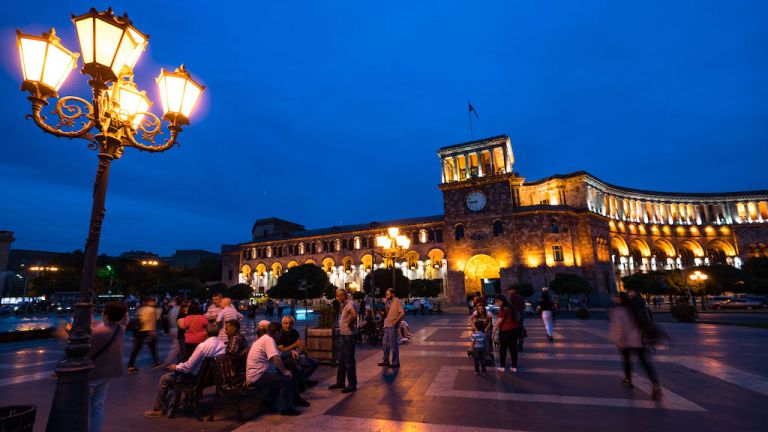Key Takeaways
Surrounded by the Caspian Sea and the Caucasus mountains, a reliable and efficient transport system is key to Azerbaijan’s economy. As the largest economy in the South Caucasus, the country has been mostly dependent on oil and natural gas exports that are vulnerable to price shocks. The Azeri oil industry generates about one-third of the country's gross domestic product but employs only 1% of the labor force.
Azerbaijan’s oil-based economic model has exhausted its growth potential, and the country now needs to diversify its economy and ensure a more balanced distribution of economic activity beyond the capital Baku.
ADB helped provide Azerbaijan the knowledge needed to improve its transport system, particularly its railways, through a $9.3 million Technical Assistance (TA) designed to help develop sustainable transport in Asia and the Pacific. It aims to help countries like Azerbaijan ensure safe, accessible, and environment-friendly transport.
The Government of Austria contributed $595,600 to this TA. Austria’s expertise was also crucial to enabling Azerbaijan to take the steps needed to make its railway transport system more sustainable.
Rolling with the times
Construction on Azerbaijan’s railways began as early as 1865 as part of the Russian Empire’s Trans-Caucasus Railway, now known as the Caucasus Transit Corridor. It was built primarily to transport oil from Baku to Poti on the Black Sea for onward shipment to Russian’s port of Novorossiysk. After the collapse of the Soviet Union in 1991, Azerbaijan regained its independence and Azerbaijan Railways (ADY) was established to independently manage and maintain the country’s railways.
Initially, the country’s railroads fell into decline. Economic relations with neighboring countries were cut off, freight and passenger transportation were minimized, and some routes were discontinued. But things have changed since then – the network has developed rapidly and now stretches for more than 4,000 km.
Yet, parts of Azerbaijan’s transport network remain in poor condition, leading to high costs, long travel times, and poor safety that translates into higher consumer goods prices. The railway’s poor condition also limits access to economic opportunities, education, and social services, especially in secondary towns and rural areas.
Decades of deteriorating infrastructure and rolling stock as well as a lack of commercial orientation in management affected ADY’s competitiveness and financial viability, and it embarked on a comprehensive reform program with ADB’s support. One key aspect was rail asset management, which covers the railways’ entire lifecycle to optimize performance and costs. This also includes the deployment of digital technology, enabling predictive and preventative maintenance, avoiding the need for repairs.
On the right track
Expert advice was needed to ensure ADY was on the right track. The Austrian Federal Railways, commonly known as ÖBB, is the most profitable in the European Union. This excellent railway system has turned landlocked Austria into a logistical hub for Central and Southeast Europe. It also ensured that economic opportunities are equally accessible all over the country: Austria is in the top 25% of countries for the lowest regional disparities in GDP per capita.
The Institute of Railway Engineering and Transport Economy at the Graz University of Technology (TU Graz) in Austria, meanwhile, places a strong emphasis on the economic and environmental sustainability of new and existing routes, lifecycle costs and assessment, and optimizing maintenance based on data analytics and predictive maintenance.
Starting in 2018, ADB, the Austrian Ministry of Finance and TU Graz jointly organized seminars attended by participants including from Azerbaijan, learned more about rail asset management including the benefits of regular and preventive maintenance, lifecycle costs components, and the consequences to total service life.
“Life cycle management must always bring together a deep understanding of the technical issues as well as the economic evaluations. This holistic view is needed to raise the efficiency of the public sector,” said TU Graz professor Dr. Peter Veit.
With Austrian expertise and training by TU Graz, ADY obtained a thorough understanding of how to manage rail assets and their demand for training increased. The support enabled Azerbaijan to take steps to transform ADY into a sustainability-oriented company in terms of technology and economic efficiency, helping it improve public services and support economic diversification.
An enhanced railway system will also underline Azerbaijan’s important role in regional connectivity. The country is a member of the Central Asia Regional Economic Cooperation (CAREC) Program, which promotes economic growth and sustainable development through cooperation among its 11 member countries. ADB, TU Graz and ÖBB are now looking to replicate the successful railway work in other countries in the region, including Georgia.
“Shifting from curative to predictive maintenance is critical to support the sustainability of rail assets,” said ADB Principal Transport Specialist Bertrand Goalou. “It also creates the conditions for improved efficiency, safety, and financial management of transport systems.”
ADB, Azerbaijan and Europe
Since Azerbaijan joined ADB in 1999, ADB has been one of the country’s key sources of official development assistance. ADB operations are being implemented under the Country Partnership Strategy 2019–2023, which aims to boost private sector development, raise public sector efficiency, improve infrastructure, and strengthen human capital. The strategy is closely aligned with the Government of Azerbaijan’s strategic roadmaps for the national economy and main economic sectors. To date, ADB has committed 76 public sector loans, grants, and technical assistance totaling $3.64 billion to Azerbaijan.
ADB’s European Representative Office, based in Frankfurt, Germany, works with companies and governments across ADB’s 17 European member countries to facilitate the application of European expertise in ADB projects in its developing member countries.






